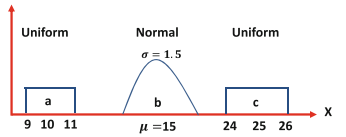Dear All,
I have a linear programming problem (from a book of optimization in power system) with uncertain parameters as:
max z = 750x1 + 1000x2subject to:
x1 + x2 <= a
x1 + 2x2 <= b
4x1 + 3x2 <= c
x1,x2 >= 0where a, b, and c are uncertain parameters with the probability function as:

How to implement this optimization problem in AIMMS?
Thank you.
Best answer by FergusHathorn
View original

